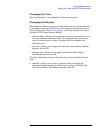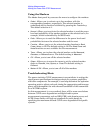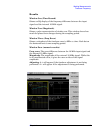
136 Chapter 4
Making Measurements
Making the Power Stat CCDF Measurement
Making the Power Stat CCDF Measurement
Purpose
Many of the digitally modulated signals now look noise-like in the time
and frequency domain. This means that statistical measurements of the
signals can be a useful characterization. Power Complementary
Cumulative Distribution Function (CCDF) curves characterize the
higher level power statistics of a digitally modulated signal. The curves
can be useful in determining design parameters for digital
communications systems.
The power statistics CCDF measurement can be affected by many
factors. For example, modulation filtering, modulation format,
combining the multiple signals at different frequencies, number of
active codes and correlation between symbols on different codes with
spread spectrum systems. These factors are all related to modulation
and signal parameters. Factors like signal compression and expansion
by non-linear components, group delay distortion from filtering, and
power control within the observation interval also affect the
measurement.
Measurement Method
The power measured in power statistics CCDF curves is actually
instantaneous envelope power defined by the equation:
P = (I
2
+ Q
2
) / Z
o
(where I and Q are the quadrature voltage components of the waveform
and Z
o
is the characteristic impedance).
A CCDF curve is defined by how much time the waveform spends at or
above a given power level. The percent of time the signal spends at or
above the level defines the probability for that particular power level.
To make the power statistics CCDF measurement, the transmitter
tester uses digital signal processing (DSP) to sample the input signal in
the channel bandwidth.
The Gaussian distribution line as the band-limited gaussian noise
CCDF reference line, the user-definable reference trace, and the
currently measured trace are shown on a semi-log graph. If the
currently measured trace is above the user reference trace, it means
that the higher peak power levels against the average power are
included in the input signal.
For power statistics CCDF measurements using baseband I/Q inputs
see “Using Baseband I/Q Inputs (Option B7C)” on page 151.


















